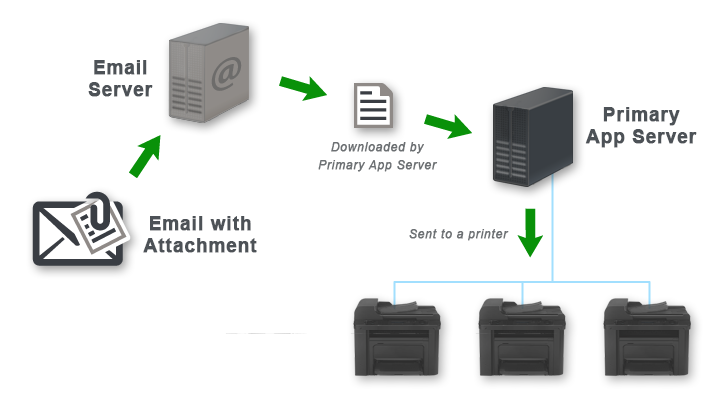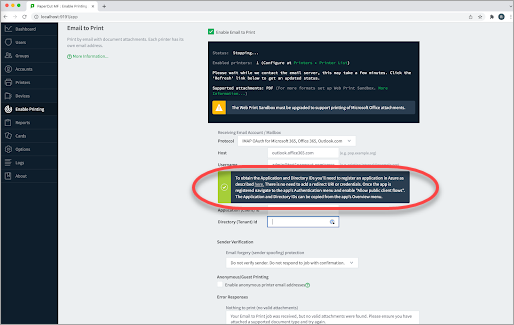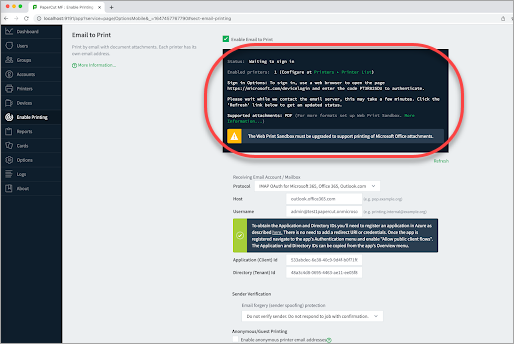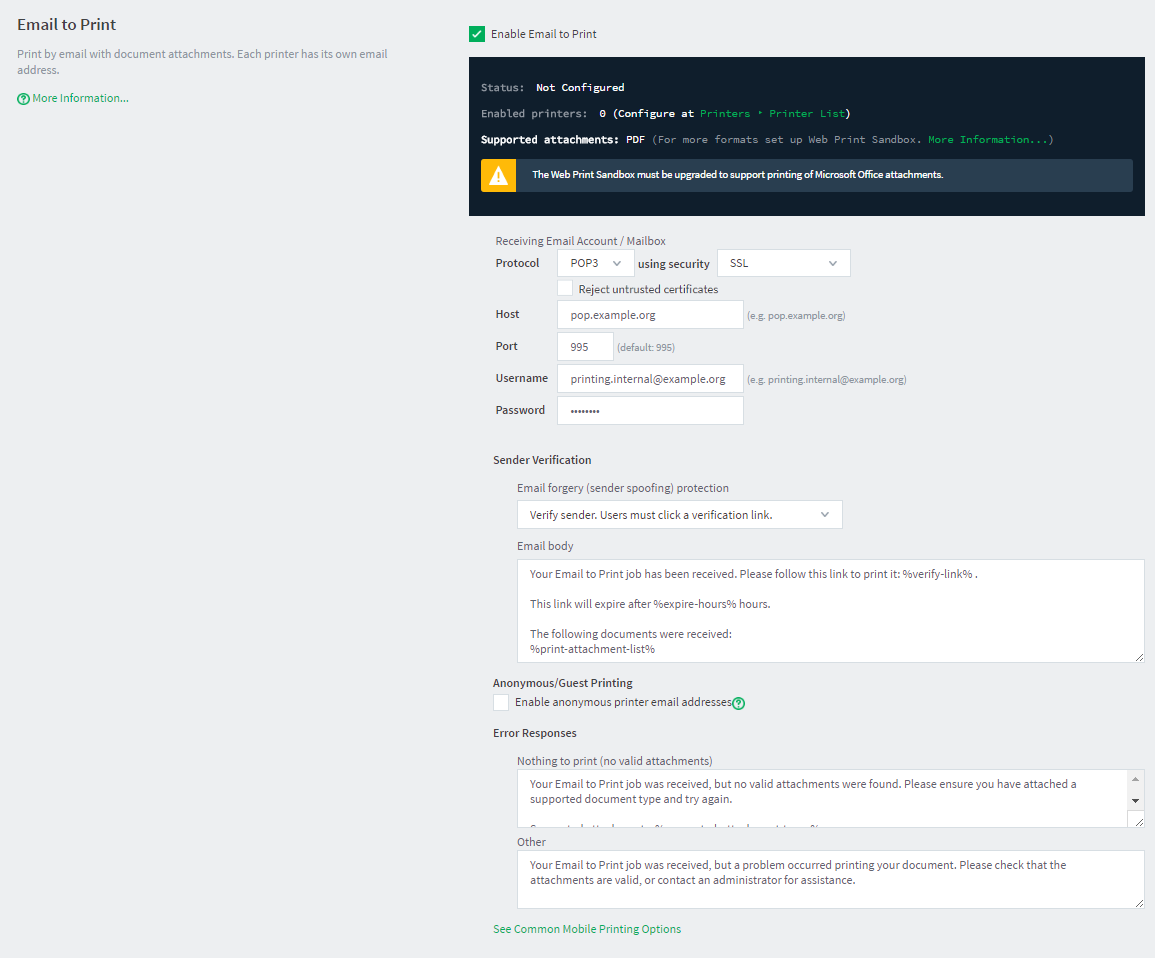Overview
Email to Print allows users to print by emailing their documents to a special address. No client software or drivers are required, providing a simple way for your organization to print from any device that can send an email.
Email to Print is part of a collection of solutions to manage mobile and BYOD printing. For more information see Mobile & BYOD printing .
How does it work?
- Each printer has a unique email address, for example,
printing@example.org - Users compose an email, attach printable document(s), and email it to the printer’s address.
- PaperCut receives the email and prints the documents on behalf of the user.

Email to Print workflow
Solution summary
- Easy to set up, easy to use.
- Works with nearly any device (anything that can send an email with an attachment).
- All print options are locked to the OS print queue defaults.
- Various setup options. See the following table for supported formats and platform/mode combinations.
| Primary server type | Default mode | Sandbox mode |
|---|---|---|
| Microsoft Windows | Yes (PDF and picture files only) | Yes. All formats supported |
| Apple Mac | Yes (PDF only) | Yes. All formats supported |
| Linux running CUPS | Yes (PDF only) | Yes. All formats supported |
| Novell OES Linux | No. Default Mode not supported | Yes. All formats supported. |
Before you start: aliases
When processing Email to Print jobs, PaperCut connects to a single mailbox on a mail server. The mailbox receives the emails of all printers, where each printer has its own email alias. This is achieved in one of three possible ways:
- Dynamic aliases—Many email servers support the dynamic alias “
+syntax”, for example,printing+library@example.comgets delivered to theprintingmailbox. This is the simplest option to set up and maintain. However, removing or renaming a dynamic alias doesn’t stop emails for the now defunct printer name. Also, the email addresses are arguably not as nice to look at! - Server-side aliases—The email address for each printer is an email alias of the mailbox, for example,
library@example.orgis an alias ofprinting@example.org. - Email forwarding—If options one and two are not possible with your email server, another option is to configure one mailbox per printer. Each mailbox could then forward all mail to the “main” mailbox, for example,
library@example.orgis a mailbox that forwards toprinting@example.org.
Pick a strategy that suits your environment and you are ready to start.
Prepare the PaperCut server
-
Configure your SMTP server details in PaperCut at Options > Notifications.
This is required so PaperCut can respond to user emails, for example, to let them know their job has been received.
-
Configure a user-facing server address at Options > Advanced > Server Address > Server address presented to users.
Email to Print sends emails to users that include links to the PaperCut server, so it needs to know the server’s network address. If you want to support Email to Print from the internet, this address needs to resolve both internally and externally to your network, for example, a fully qualified public DNS name.
For more details see Change the server address presented to users .
Setting up a mailbox
-
Set up a new mailbox on your email server. Email to Print supports mailboxes with either POP3 or IMAP protocols.
This mailbox receives all emails for Email to Print. Each email is deleted from the email server after it is processed, so the storage requirements should not be large.
-
Select Enable Printing > Mobile & BYOD. The Mobile & BYOD page is displayed.
-
In the Email to Print area, select the Enable Email to Print check box.
-
Configure the Receiving Email Account / Mailbox area according to your mail server and newly created mailbox. Note that with some email servers, the Username might not be in the email address format.
-
Select the protocol below that you are using and follow the steps in the drop-down.

IMAP OAUTH for Microsoft 365, Office 365, Outlook.com
1. Follow the instructions to obtain the Application and Directory IDs by registering an Application in Azure.

-
If this is the fist time you have enabled Email to Print, the Status will be Not Configured. If the Status is Stopping, refresh the page again to update the status to Not Configured. It can take up to a minute for the status to change.
-
Enter the ClientId and TenantId and click Apply.
-
Follow the instructions in the top box next to Sign in options to enter the deviceCode to authenticate.

- Refresh the screen again to change the Status to OK. It can take up to a minute for the status to change.
POP3 or IMAP
Leave the default settings. They will suffice for testing.

Testing Email to Print
- Click the Printers tab. The Printer List page is displayed.
- Select a printer.
The Printer Details page is displayed showing the Summary tab contents. - In the Email to Print area, give the printer a unique and simple email alias.
- Depending on your chosen alias type, configure the email server to point the new email alias to the Email to Print mailbox (see Before You Start: Aliases ).
- Pick a test user account from the Users tab and ensure it has an associated email address you can send an email from (Primary email or Other emails). If you don’t have a test email account, you can temporarily assign your own email address to the test user.
- From the test user’s email address, compose a new email, attach a PDF, and send it to the printer’s email address (the alias, not the mailbox).
- In a short time you should receive a verification email (see Customization ). Click the link in this email. Your job should now print!
- Check your job printed successfully, and inspect the print log at Printers > Job Log.
If you want to support Microsoft Office document attachments in addition to PDF and picture files, see Adding support for Microsoft Office Documents .
Continue with Customization below to tweak settings to your site’s needs.
Customization
The following customization settings are in Options > Mobile & BYOD > Email to Print.
- Sender verification
This option controls how PaperCut responds when it receives an Email to Print job from a user.
The default setting, Verify sender. Users must click a verification link., sends an email with a link the user must click before their job is printed (or proceeds to the next stage, such as a Secure print release ). The purpose of this setting is to verify the sender of the email actually owns the email address. In the Email body for this setting, the special replacement marker%verify-link%is required.
If verification of the sender address is not important, you can use the setting Do not verify sender. Respond to job with confirmation.. When this setting is used, jobs are processed immediately, and the user receives an email to let them know their job was received. In the Email body for this setting, use the special replacement marker%client-url%as a link to the Mobile web client, which shows the job’s status. - Anonymous/guest submission
This item enables the sending of Email to Print jobs from anonymous guest users. These jobs are sent to a special guest printer alias. Jobs are logged to the specified user (default isguest-user.)
See Anonymous setup for more information. - Error responses
These options allow the customization of response emails sent to users when things go wrong.- Nothing to print (no valid attachments)—Used when an email is received but no valid attachments were found. The user might have forgotten to attach their document, or perhaps attached an unsupported document type.
- Other—Used when any other problem occurs e.g. if the document was corrupt and couldn’t be printed, or something went wrong with the print driver attempting to print.
The following special replacement markers can be used in each of the customization settings.
| Special replacement marker | Description |
|---|---|
| %printer% | The name of the printer. |
| %printer-server% | The server name component in the printer's name. |
| %printer-queue% | The queue name component in the printer's name. |
| %location% | The printer location/department. |
| %document% | The document name. |
| %print-attachment-list% | A list of email attachments to be printed. |
| %expire-hours% | The number of hours before the email verification link expires. |
| %supported-attachment-types% | Supported email attachment types. |
| %verify-link% | The verification URL that a user must click before their job is printed. |
| %client-url% | The Mobile Client URL. |
See Self association for emails and email verification/validation for additional customization settings that apply to both Email to Print and Google Cloud Print.
Interaction with other features
User interactions (account selection, confirmation, print scripts)
If users are configured with Account Selection options (or you have print scripts) that require user interaction that can ONLY be done via the Mobile web client (and cannot be done at the printing device), then running the Mobile web client is mandatory. If not, the user is unable to carry out the configured user interaction for Account Selection, and the Email to Print job remains paused and does not appear on the printing device. To make this easy use the default job response templates and include links to the Mobile web client. You can tweak the templates to indicate that users must follow the included link to progress their job.
However, if users are configured with Account Selection options that require user interaction and this can be done BOTH via Mobile web client AND at the printing device (the ability to assign accounts at the printing device is available), running the Mobile web client is not mandatory. It may be required if it is also being used for other purposes, besides Account Selection (such as, viewing current account balance, cached user comments, “low credit” warning messages, notifications about print policies, etc). For more information, see Mobile web client and Changing attributes of print jobs at the device
Hold/release queues
Hold/release queues allow jobs to be held in a queue and later released by a user. This can be used, for example, to require that users are physically at the device to collect their job (“secure print release”).
You can use hold/release queues with Email to Print in the same way as other job types. For more information on hold/release queues, see Secure print release .
Find-Me Printing
Find-Me Printing removes the need for a user to select a printer when printing their job. Instead they print to a “virtual”, sometimes called “global”, queue. They then release their job at the device of their choosing. PaperCut handles routing of the job to the right printer.
You can use Find-Me Printing with Email to Print in the same way as other job types. For more information see Find-Me printing and printer load balancing .
Internal users
Internal users are users who exist only in the PaperCut database, not in the organization’s domain. They allow you to quickly set up users for printing (or have users set up their own account) without having to go through the normal process of creating full domain accounts.
You can combine internal Users with Email to Print, allowing users to register their own account (and email address) to set themselves up for printing. The recommended approach is as follows:
- Enable internal user self-registration (see Internal users (users managed by PaperCut NG/MF) . This adds a link to the login screen for users to create a new username, password and email.
- Enable email self-association (see Unknown emails and email self-association ). This allows jobs from unknown email addresses to be held until the email “becomes known”. When the user sends their first job via Email to Print, they will receive a response email asking to verify their email address by logging in. Change this default template to be “If you do not have a username, create one using the Register link on the login screen” or something similar.
After the user has verified their email address, their job continues to print. Future jobs print as per normal.
Adding support for Microsoft Office documents
Email to Print prints PDF and picture file attachments by default (See Supported Applications and File Formats for full details). You can add support for Microsoft Office document attachments by configuring a Web Print Sandbox running Microsoft Office. The Web Print Sandbox functions as a document conversion service. Incoming email attachments are sent to the sandbox, and the associated Microsoft Office program automatically converts the source document to a PDF file, which is then sent to the printer.
See Sandbox Mode Setup for information on how to set up a Web Print Sandbox running Microsoft Office.
Rollout
The following is a list of considerations when moving from a test Email to Print environment that is working as desired, to a wider or organization-wide rollout.
- Create and publish printer aliases for all printers available via Email to Print. This could involve:
- Adding the printer’s email to a sign on the printer
- Publishing a web page with email addresses for all printers
- Adding printer email addresses to a shared address book
- Modify the procedure for creating new printers in PaperCut to optionally include an Email to Print alias.
Advanced configuration
The following Email to Print settings are for advanced users or special cases, and does not normally need to change. They are found in the PaperCut Config Editor. See [Using the Advanced Config Editor]/help/manuals/ng-mf/common/sys-config-editor/) for more information on advanced configurations.
Email to Print advanced configuration
| Config Name | Description |
|---|---|
| email-printing.attachment-min-image-bytes | Often emails have small images attached as part of the email signature, which users are not likely to want printed. To avoid printing these images, Email to Print ignores image attachments smaller than this value. The default value is 20000 bytes. |
| email-printing.debug | Set this to Y to enable detailed logging of Email to Print emails received, emails sent, and how PaperCut is connecting to the email server. |
| email-printing.service-freq-secs | By default, PaperCut checks (poll) for new emails every 20 seconds. This config item can change the polling frequency. Less than 20 seconds is not recommended so not to burden the email server. If this value is too large, users will find that sometimes jobs will take a long time to print. How long "too long" will vary between sites. |
| email-printing.imap-read-folder | By default, PaperCut looks at the 'Inbox' folder of the mailbox. This is usually the right setting for most mailboxes. When using IMAP as the protocol, emails can be from any folder on the mail server; so if you want to read emails from a specific folder (e.g. setting a rule to forward emails with attachments to a pre-defined 'PrintQueue' folder) you can set the folder name here. |
Print options
As the user communicates with Email to Print through emails, there is little opportunity for setting print options. Instead, PaperCut attempts to use default settings for the printer.
Setting printer defaults
Email to Print printing is performed by the PaperCut Print Provider running on the print server for the target printer.
On CUPS print servers, Email to Print uses the default printer settings.
On Windows print servers, default printer settings are configured under: Start > Devices and Printers > your printer > Printing Preferences
However, these printer settings are not available when the Print Provider service is running under the SYSTEM account, which is the default. If you want Email to Print to use the Windows printer defaults (Printing Preferences), run the Print Provider service under a user account that has access to the Windows printer settings.
- Select Start > Control Panel > Administrative Tools > Services.
- Find the
PaperCut Print Providerservice; then select Properties > Log On. - Set a user account that has access to the Windows printer settings.
Image print scaling
When printing large image file attachments, Email to Print might need to rotate and/or scale the image to make it fit on the page.
To do this, Email to Print assumes a page size of either A4 or Letter. If an image is too large to fit on an A4 or Letter sized page, Email to Print rotates and/or scales down the image as needed to fit.
FAQs
Can multiple documents be printed at once?
Can a job be printed on more than one printer at a time?
Will you add support for HTML formatting in the reply emails?
I encrypt/sign my emails, do you support PGP and similar features?
I want to support Email to Print without assigning email addresses to users (and without requiring users to associate their own address with their account) i.e. to allow printing without user-level control. Will you add support for this?
guest). Please email support to let us know you’re interested!
My email server supports SPF (Sender Policy Framework) header checking. Can you add functionality to send a confirmation response when it checks out, and a verification response when it doesn't?
Troubleshooting
I'm having trouble setting up Google OAuth2 or IMAP OAuth for Office 365 with Email to Print, where can I find help?
My users are having my Email to Print response emails flagged as spam. How can I prevent this?
-
Ensure you have configured a public DNS name for your PaperCut server and have configured it at Options > Advanced > Server Address > Server address presented to users , so your response emails do not contain (internal) IP addresses.
-
Ensure you are using a valid SMTP ‘From’ address ( Options > Notifications > Email Options > From address ). For the best user experience, use an attended email address.
The links in my PaperCut response emails contain IPs. How can I use a DNS name?
The Email to Print status in the Admin web interface says there is an error. What should I do?
-
Check the App. Log tab for any obvious errors.
-
Check your Email to Print mail server configuration. Ensure the server name, username, password etc. are all correct.
-
If there is no obvious cause, contact support for assistance.
Email to Print jobs are not coming out of the printer, but the status in the Admin web interface says OK. What should I do?
-
Check the Application Log tab for any obvious errors.
-
On the Dashboard tab, check the Realtime Activity area. This contains a lot of information about the state of print jobs. Try sending a new Email to Print job while watching this status area. Look for messages about the job being held in a hold/release queue, etc.
-
Is the job:
-
canceled, because the email address was unknown?
-
canceled due to filters or not enough credit?
-
awaiting the user to verify their email?
-
awaiting the user to click a job verification link? (is the email in the user’s spam folder?)
-
awaiting account selection, job confirmation, or a print script popup? (try opening the Mobile web client)
-
held in a hold/release queue?
-
-
If it’s still a mystery, contact support for assistance.
If your print server is a Windows Server Core and the text in your Email to Print jobs is missing or not rendering properly, the problem might be due to missing fonts.
-
On a standard Windows server, open the Registry Editor.
-
Export the following registry:
[HKEY_LOCAL_MACHINE\SOFTWARE\Microsoft\Windows NT\CurrentVersion\Fonts] -
Copy the fonts registry file to the Print Server
-
On the print server, create the following folder:
C:\Windows\Fonts -
On the standard Windows server, copy all of the font files in
C:\Windows\Fontsto the same location on the print server. -
On the print server, open the Registry Editor.
-
Import the fonts registry file.
-
Restart the print server.




Comments